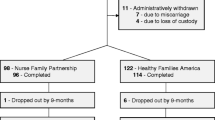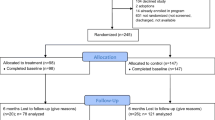Abstract
Prevention of maltreatment and harsh parenting are the primary goals of evidence-based home visiting programs, but rigorous studies demonstrating long-term outcomes are limited despite widespread implementation. The current study examines data from a 7-year follow-up study of a randomized controlled trial of Healthy Family New York (HFNY). Specifically, the study examines whether HFNY participation predicts lower rates of harsh and abusive parenting 7 years after enrollment. The data include both maternal self-report of parenting behaviors as well as the target child’s report of harsh parenting. The year 7 sample included 942 mother interviews (83.5% retention from baseline) and 800 child interviews. At the 7-year follow-up, maternal-reported behaviors measured by CTS-PC showed a significantly increased use of positive parenting strategies and lower levels of serious physical abuse in the HFNY group compared with the control group. Significant group differences were observed for the frequency with which mothers engaged in severe or very severe physical assault (control group = .16, compared with .03 in the intervention group, p < .001). In addition, fewer children reported that their parents used minor physical assault. There was no intervention impact on indicated child protective service records. The current study indicates that home visiting participation reduces harsh and abusive parenting and promotes positive parenting behaviors that endure and may strengthen later development.

Similar content being viewed by others
References
Chan, K. L. (2012). Comparison of parent and child reports on child maltreatment in a representative household sample in Hong Kong. Journal of Family Violence, 27, 11–21.
Colman, D. L., Dodge, K., & Campbell, S. K. (2010). Where and how to draw the line between reasonable corporal punishment and abuse. Law and Contemporary Problems, 73, 107–166.
Drake, B., & Jonson-Reid, M. (2018). Defining and estimating child maltreatment. In J. Conte & B. Klika (Eds.), APSAC Handbook of Maltreatment (4th ed.). Washington DC: Sage Publishing.
Duggan, A., McFarlane, E., Fuddy, L., Burrell, L., Higman, S. M., & Windham, A. (2004). Randomized trial of a statewide home visiting program: Impact in preventing child abuse and neglect. Child Abuse & Neglect, 28, 597–622.
DuMont, K. A., Mitchell-Herzfeld, C., Greene, R., Lee, E., Lowenfels, A., & Rodriguez, M. (2008). Healthy Families New York randomized trial: Effects on early child abuse and neglect. Child Abuse & Neglect, 32, 295–315.
Easterbrooks, M. A., Kotake, C., & Fauth, R. (2019). Recurrence of maltreatment after newborn home visiting: A randomized controlled trial. American Journal of Public Health, 109, 729–735. https://doi.org/10.2105/ajph.2019.304957.
Eckenrode, J., Campa, M. I., Morris, P. A., Henderson, C. J., Bolger, K. E., Kitzman, H., & Olds, D. (2017). The prevention of child maltreatment through the Nurse Family Partnership program: Mediating effects in a long-term follow-up study. Child Maltreatment, 22, 92–99.
Florida State University Center for Prevention and Early Intervention Policy. (2011). Partners for a healthy baby home visiting curriculum: Baby’s first six months. Tallahassee: Florida State University Center for Prevention and Early Intervention Policy.
Green, B. L., Tarte, J. M., Harrison, P. M., Nygren, M., & Sanders, M. B. (2014). Results from a randomized trial of the Healthy Families Oregon accredited statewide program: Early program impacts on parenting. Children and Youth Services Review, 44, 288–298.
Green, B. L., Sanders, M. B., & Tarte, J. (2017). Using administrative data to evaluate the effectiveness of the Healthy Families Oregon home visiting program: 2-year impacts on child maltreatment & service utilization. Children and Youth Services Review, 75, 77–86.
Green, B., Sanders, M. B., & Tarte, J. M. (2020). Effects of home visiting program implementation on preventive health care access and utilization: Results from a randomized controlled trial of Healthy Families Oregon. Prevention Science, 21, 15–24.
Guterman, N. B., Tabone, J. K., Bryan, G. M., Taylor, C. A., Napoleon-Hanger, C., & Banman, A. (2013). Examining the effectiveness of home-based parent aide services to reduce risk for physical child abuse and neglect: Six-month findings from a randomized clinical trial. Child Abuse and Neglect, 37, 566–577.
Jacobs, F., Easterbrooks, A., Mistry, J., Bumgarner, E., Raskin, M., Fosse, N., et al. (2016). Improving adolescent parenting: Results from a randomized, controlled trial of a home visiting program for young families. American Journal of Public Health, 106, 342–349.
Kobulsky, J. M., Kepple, N. J., Holmes, M. R., & Hussey, D. L. (2017). Concordance of parent- and child-reported physical abuse following Child Protective Services investigation. Child Maltreatment, 22, 24–33. https://doi.org/10.1177/1077559516673156.
Korfmacher, J. (2000). The Kempe Family Stress Inventory: A review. Child Abuse & Neglect, 24, 129–140.
Latimore, A., Burrel, L., Crowne, S., Ojo, K., Cluxton-Keller, F., Gustin, S., et al. (2017). Exploring multilevel factors for family engagement in home visiting across two national models. Prevention Science, 18, 577–589.
LeCroy, C. W., & Lopez, D. (2018). A randomized controlled trial of healthy families: 6-month and 1-year follow-up. Prevention Science, 21, 1–11.
Lee, E., Kirkland, K., Miranda-Julian, C., & Greene, R. (2018). Reducing maltreatment recurrence through home visitation: A promising intervention for child welfare involved families. Child Abuse & Neglect, 86, 55–66.
Levey, E. J., Gelaye, B., Bain, P., Rondon, M. B., Borba, C. P., Henderson, D. C., et al. (2017). A systematic review of randomized controlled trials of interventions designed to decrease child abuse in high-risk families. Child Abuse & Neglect, 65, 48–57.
Matone, M., Kellom, K., Griffis, H., Quarshie, W., Faerber, J., Gierlach, P., et al. (2018). A mixed methods evaluation of early childhood abuse prevention within evidence-based home visiting programs. Maternal and Child Health Journal, 22, 79–91.
Mebert, C., & Straus, M. A. (2002). Picture-card version for young children of the parent-to-child conflict tactics scales. Durham, NH: University of New Hampshire.
Mitchell-Herzfeld, S., Izzo C., Greene, R., Lee, E., & Lowenfels, A. (2005). Evaluation of Healthy Families New York (HFNY): First year program impacts. Rensselaer, NY: New York State Office of Children & Family Services.
National Home Visiting Resource Center. (2018). 2018 Home visiting yearbook. Arlington, VA: James Bell Associates and The Urban Institute.
Newbury, J. B., Arseneault, L., Moffitt, T. E., Caspi, A., Danese, A., Baldwin, J. R., & Fisher, H. L. (2018). Measuring childhood maltreatment to predict early-adult psychopathology: Comparison of prospective informant-reports and retrospective self-reports. Journal of Psychiatric Research, 96, 57–64.
Olds, D. L. (2006). The nurse–family partnership: An evidence-based preventive intervention. Infant Mental Health Journal, 27, 5–25.
Olds, D., Henderson Jr., C. R., Kitzman, H., & Cole, R. (1995). Effects of prenatal and infancy nurse home visitation on surveillance of child maltreatment. Pediatrics, 95, 365–372.
Olds, D. L., Eckenrode, J. J., Henderson Jr., C. R., Kitzman, H., Powers, J., Cole, R., et al. (1997). Long-term effects of home visitation on maternal life course, child abuse and neglect: Fifteen-year follow-up of a randomized trial. Journal of the American Medical Association, 278, 637–643.
Radloff, L. (1977). The CES-D scale: A self-report depression scale for research in the general population. Applied Psychological Measurement, 1, 385–401.
Rodriguez, M. L., Dumont, K., Mitchell-Herzfeld, S. D., Walden, N. J., & Greene, R. (2010). Effects of Healthy Families New York on the promotion of maternal parenting competencies and the prevention of harsh parenting. Child Abuse & Neglect, 34, 711–723.
Sama-Miller, E., Akers, L., Mraz-Esposito, A., Avellar, S., Paulsell, D., & Del Grosso, P. (2017). Home visiting evidence of effectiveness review: Executive summary. Washington, DC: Office of Planning, Research and Evaluation, U.S. Department of Health and Human Services.
Sierau, S., White, L. O., Klein, A. M., Manly, J. T., von Klitzing, K., & Herzberg, P. Y. (2018). Assessing psychological and physical abuse from children’s perspective: Factor structure and psychometric properties of the picture-based, modularized child-report version of the Parent-Child Conflict Tactics Scale-Revised (CTSPC-R). PLoS One, 13, e0205401.
Straus, M. A., Hamby, S. L., Finkelhor, D., Moore, D. W., & Runyan, D. (1998). Identification of child maltreatment with the Parent-Child Conflict Tactics Scales: Development and psychometric data for a national sample of American parents. Child Abuse & Neglect, 22, 249–270.
Viera, A. J., & Garrett, J. M. (2005). Understanding interobserver agreement: The kappa statistic. Family Medicine, 37, 360–363.
Acknowledgments
We would like to extend our sincere thanks to all families participated in the trial and research interviewers and staff involved in data collection.
Funding
The study is financially supported by the research, authorship, and/or publication of this article: National Institute of Justice Grant 2006-Mu-Mu-0002 and NYS Office of Children and Family Services grant number 1058555-1-41144.
Author information
Authors and Affiliations
Corresponding author
Ethics declarations
Conflict of Interest
The authors declare that they have no conflict of interest.
Ethical Approval
The research protocol was approved by the Institutional Review Board at University at Albany, the State University of New York (IRB approval #00-246).
Informed Consent
A research staff contacted the mother by phone, described the interview process, and scheduled a time to meet over phone. Once in the home, the interviewer answered mothers’ questions about the study and obtained informed consent from the mother to conduct her interview, as well as consent for her child to participate in an interview. When the mother provided consent to interview the child, the interviewer also explained the study and obtained the child’s assent to participate.
Additional information
Publisher’s Note
Springer Nature remains neutral with regard to jurisdictional claims in published maps and institutional affiliations.
Rights and permissions
About this article
Cite this article
Kirkland, K., Lee, E., Smith, C. et al. Sustained Impact on Parenting Practices: Year 7 Findings from the Healthy Families New York Randomized Controlled Trial. Prev Sci 21, 498–507 (2020). https://doi.org/10.1007/s11121-020-01110-w
Published:
Issue Date:
DOI: https://doi.org/10.1007/s11121-020-01110-w




